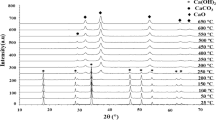Abstract
Monodispersed microsized copper oxalate particles were prepared in a segmented continuous flow tube reactor, and the effect of the main parameters such as organic additive agent, initial copper ions concentration, residence time, and segmented media on the final products were investigated experimentally. The obtained copper oxalate microsized particles were disc-like in the presence of citrate ligand, which was the shape inducer for the precipitated copper oxalate. Thermodynamic equilibrium diagrams of the Cu(II)-oxalate-H2O, Cu(II)-oxalate-citrate-H2O, and Cu(II)-oxalate-EDTA-H2O solution systems were drawn to estimate the possible copper species under the experimental conditions and to explain the formation mechanisms of copper oxalate particles in the segmented fluidic reactor. Both theoretical and experimental results indicated that the presence of chelating reagents such as citrate and EDTA had distinct effect on the evolution of particle shape. Air and kerosene were tested as media for the fluidic flow segmentation, and the latter was verified to better promote the growth of copper oxalate particles. The present study provides an easy method to prepare monodispersed copper oxalate microsized particles in a continuous scaling-up way, which can be utilized to prepare the precursor material for conductive inks.
Similar content being viewed by others
References
F. Roux, S. Amtablian, M. Anton, et al., Chalcopyrite thin-film solar cells by industry-compatible ink-based process, Sol. Energy Mater. Sol. Cells, 115(2013), p. 86.
H. Min, B. Lee, S. Jeong, and M. Lee, Fabrication of 10 µm-scale conductive Cu patterns by selective laser sintering of Cu complex ink, Opt. Laser Technol., 88(2017), p. 128.
C.W. Chang, T.Y. Cheng, and Y.C. Liao, Encapsulated silver nanoparticles in water/oil emulsion for conductive inks, J. Taiwan Inst. Chem. Eng., 92(2018), p. 8.
S. Bose, S. Chakraborty, and D. Sanyal, Water-ethylene glycol mediated synthesis of silver nanoparticles for conductive ink, Mater. Today Proc., 5(2018), No. 3, p. 9941.
J. Kastner, T. Faury, H.M. Außerhuber, et al., Silver-based reactive ink for inkjet-printing of conductive lines on textiles, Microelectron. Eng., 176(2017), p. 84.
Z.H. Wang, W. Wang, Z.K. Jiang, and D. Yu, Low temperature sintering nano-silver conductive ink printed on cotton fabric as printed electronics, Prog. Org. Coat., 101(2016), p. 604.
B.J. De Gans, P.C. Duineveld, and U.S. Schubert, Inkjet printing of polymers: State of the art and future developments, Adv. Mater., 16(2010), No. 3, p. 203.
D. Kim, S. Jeong, and J. Moon, Synthesis of silver nanoparticles using the polyol process and the influence of precursor injection, Nanotechnology, 17(2006), No. 16, p. 4019.
T. Öhlund, A.K. Schuppert, M. Hurnmelgård, J. Bäckström, H.E. Nilsson, and H. Olin, Inkjet fabrication of copper patterns for flexible electronics: Using paper with active precoatings, ACS Appl. Mater. Interfaces, 7(2015), No. 33, p. 18273.
Y. Hokita, M. Kanzaki, T. Sugiyama, R. Arakawa, and H. Kawasaki, High-concentration synthesis of sub-10 nm copper nanoparticles for application to conductive nanoinks, ACS Appl. Mater. Interfaces, 7(2015), No. 34, p. 19382.
T. Sugiyama, M. Kanzaki, R. Arakawa, and H. Kawasaki, Low-temperature sintering of metallacyclic stabilized copper nanoparticles and adhesion enhancement of conductive copper film to a polyimide substrate, J. Mater. Sci. Mater. Electron., 27(2016), No. 7, p. 7540.
A. Yabuki, Y. Tachibana, and I.W. Fathona, Synthesis of copper conductive film by low-temperature thermal decomposition of copper-aminediol complexes under an air atmosphere, Mater. Chem. Phys., 148(2014), No. 1–2, p. 299.
A. Yabuki, N. Arriffin, and M. Yanase, Low-temperature synthesis of copper conductive film by thermal decomposition of copper-amine complexes, Thin Solid Films, 519(2011), No. 19, p. 6530.
A. Yabuki and S. Tanaka, Electrically conductive copper film prepared at low temperature by thermal decomposition of copper amine complexes with various amines, Mater. Res. Bull., 47(2012), No. 12, p. 4107.
D. Adner, F.M. Wolf, S. Möckel, J. Perelaer, U.S. Schubert, and H. Lang, Copper(II) ethylene glycol carboxylates as precursors for inkjet printing of conductive copper patterns, Thin Solid Films, 565(2014), p. 143.
Y. Dong, X.D. Li, S.H. Liu, Q. Zhu, M. Zhang, J.G. Li, and X.D. Sun, Optimizing formulations of silver organic decomposition ink for producing highly-conductive features on flexible substrates: The case study of amines, Thin Solid Films, 616(2016), p. 635.
A.T. Royappa, A.D. Royappa, R.F. Moral, et al., Copper(I) oxalate complexes: Synthesis, structures and surprises, Polyhedron, 119(2016), p. 563.
A. Manz, N. Graber, and H.M. Widmer, Miniaturized total chemical analysis systems: A novel concept for chemical sensing, Sens. Actuators B, 1(1990), No. 1–6, p. 244.
J.H. Chun, S. Lu, Y.S. Lee, and V.W. Pike, Fast and high-yield micro-reactor syntheses of ortho-substituted [18F]fluoroarenes from reactions of [18F]fluoride ion with diaryliodonium salts, J. Org. Chem., 75(2010), No. 10, p. 3332.
S.J. Haswell, R.J. Middleton, B. O’Sullivan, V. Skelton, P. Watts, and P. Styring, ChemInform abstract: The application of micro reactors to synthesis chemistry, Cheminform, 32(2010), No. 23, DOI: https://doi.org/10.1002/chin.200123238.
K. Schubert, J. Brandner, M. Fichtner, G. Linder, U. Schygulla, and A. Wenka, Microstructure devices for applications in thermal and chemical process engineering, Microscale Thermophys. Eng., 5(2001), No. 1, p. 17.
K. Jähnisch, V. Hessel, H. Löwe, and M. Baerns, Chemistry in microstructured reactors, Angew. Chem. Int. Ed., 43(2004), No. 4, p. 406.
M.T. Tang, Theory and Technology of Complex Metallurgy, Central South University Press, Changsha, 2011.
X.W. Yang and D.F. Qiu, Hydrometallurgy, 2nd Ed., Metallurgical Industry Press, Beijing, 2011.
X.L. Zhou, Z.G. Yan, and X.D. Han, From ascorbic acid to oxalate: Hydrothermal synthesis of copper oxalate microspheres and conversion to oxide, Mater. Lett., 118(2014), p. 39.
Author information
Authors and Affiliations
Corresponding author
Rights and permissions
About this article
Cite this article
Liu, X., Chen, X. & Huang, K. Segmented tubular synthesis of monodispersed microsized copper oxalate. Int J Miner Metall Mater 26, 460–466 (2019). https://doi.org/10.1007/s12613-019-1753-5
Received:
Revised:
Accepted:
Published:
Issue Date:
DOI: https://doi.org/10.1007/s12613-019-1753-5




